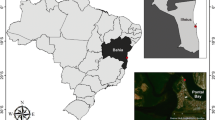Abstract
Eight tubificid species form a succession along the Thames estuary which is similar to that found in some other British & European estuaries (Fig. 1).
Access this chapter
Tax calculation will be finalised at checkout
Purchases are for personal use only
Preview
Unable to display preview. Download preview PDF.
Similar content being viewed by others
References
Alexander, W.B., Southgate, B.A. and Bassindale, R. 1935. A survey of the River Tees. Part 2-the estuary; chemical and biological. W.P.R.L. Tech. Paper No. 5.
Bagge, P. 1969. The succesion of the bottom fauna communities in polluted estuarine habitats. Limnologica, 7: 87–94.
Bagge, P. and Ilus, E. 1973. Distribution of benthic tubificids in Finnish coastal waters in relation to hydrography and pollution Oikos. Suppl. 15: 214–225.
Birtwell, I.K. 1972. Ecophysiological aspects of tubificids in the Thames estuary. Ph.D. Thesis, University of London.
Birtwell, I.K. and Arthur, D.R. 1980. The ecology of tubificids in the Thames estuary with particular references to Tubifex costatus Claparede. In “Aquatic oligochaete biology”, edited by Brinkhurst, R.O. & D.G. Cook. Plenum Press, 1980.
Brinkhurst, R.O. 1965a. Observations on the recovery of a British river from gross organic pollution. Hydrobiologia, 24: 9–51.
Brinkhurst, R.O. 1965b. The biology of the Tubificidae with special reference to pollution. In “Biological problems in water pollution”, U.S. Dept. of Health, Publication No. 999–WP–25
Brinkhurst, R.O. and Simmons, M.L. 1968. The aquatic oligochaete of the San Francisco Bay system. Calif. Fish & Game, 54: 180–194.
Fisher, J.A. and Beeton, A.M. 1975. The effect of dissolved-oxygen on the burrowing behaviour of Limnodrilus hoffmeisteri (Oligochaeta) Hydrobiologia, 47: 273–290.
Hunter, J.B. 1977. Some aspects of the ecology of tubificids in the Thames estuary. Ph.D. Thesis. University of London.
Hunter, J.B. and Arthur, D.R. 1978. Some aspects of the ecology of Peloscolex benedeni Udekem ( Oligochaeta: Tubificidae) in the Thames estuary. Estuar. cstl. mar. Sci., 6: 197–208.
Jansson, B.O. 1962. Salinity resistance and salinity preference of two oligochaetes from the interstitial fauna of marine sandy beaches. Oikos, 13: 293–305.
Kennedy, C.R. 1964a. The biology of some freshwater oligochaetes Ph.D. Thesis, University of Liverpool.
Kennedy, C.R. 1964b. Studies on the Irish Tubificidae. Proc. R. Irish Acad., 63B: 225.
Kennedy, C.R. 1966. The life history of Limnodrilus hoffmeisteri Clap. ( Oligochaeta: Tubificidae) and its adaptive significance. Oikos, 17: 159–168.
Kinne, O. 1966. Physiological aspects of life in estuaries with special reference to salinity. Nether1. J. Sea. Res., 3: 222–244.
Laakso, M. 1969. Oligochaeta from brackish water near Tvarminne, S.W. Finland, Ann. Zool. Fenn., 6: 98–111.
Ladle, M. 1971. The biology of oligochaeta from Dorset chalk streams. Freshwat. Biol. 1: 83–97.
Leppakoski, E. 1967. Notes on the aquatic oligochaeta (Annelida) of the Bothnian Bay, Finland. Aquilo, (ser. zool.) 5: 30–34.
Mackay, D.W., Tayler, W.K. and Henderson, A.R. 1978. The recovery of the polluted Clyde estuary. Proc. Roy. Soc. Edin., 76B: 135–152.
McLusky, D.S., Teare, M. and Phizacklea, P. 1980. Effects of domestic and industrial pollution on the distribution and abundance of aquatic oligochaetes in the Forth estuary. Helgolander wiss Meeresunters. In Press.
Muus, B.J. 1967. The fauna of Danish estuaries and lagoons. Meddr. Danm. Fisk. og Havanders, 5: 7–316.
Pfannkuche, 0. 1974. Zur systemtik und Okologie naidomorpher Brackwasseroligochaeten. Mitt Hamburg. Zool. Mus. Inst., 71: 115–134.
Timm, T. 1970. On the fauna of the Estonian oligochaeta. Pedobiologia, 10: 52–78.
Wharfe, J.R. 1977. An ecological survey of the benthic invertebrate macrofauna of the lower Medway estuary, Kent. J. Anim. Ecol., 46: 93–113.
Author information
Authors and Affiliations
Editor information
Editors and Affiliations
Rights and permissions
Copyright information
© 1981 Plenum Press, New York
About this chapter
Cite this chapter
Hunter, J. (1981). Survival Strategies of Tubificids in the Thames and other Estuaries. In: Jones, N.V., Wolff, W.J. (eds) Feeding and Survival Srategies of Estuarine Organisms. Marine Science, vol 15. Springer, Boston, MA. https://doi.org/10.1007/978-1-4613-3318-0_5
Download citation
DOI: https://doi.org/10.1007/978-1-4613-3318-0_5
Publisher Name: Springer, Boston, MA
Print ISBN: 978-1-4613-3320-3
Online ISBN: 978-1-4613-3318-0
eBook Packages: Springer Book Archive




